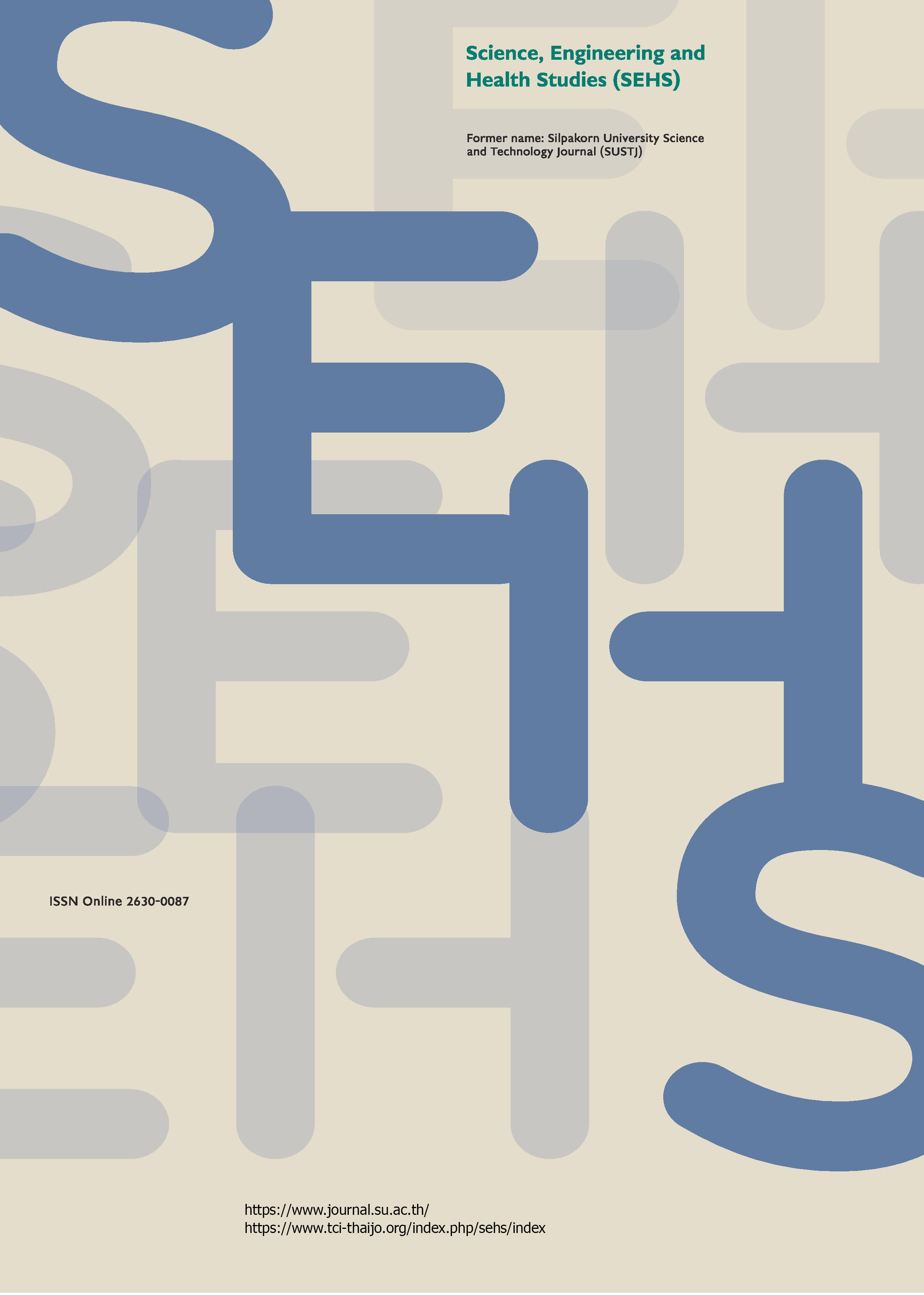Photodegradation of S-metolachlor using metal oxide doped tungsten oxide under visible light
Main Article Content
Abstract
In this research, tungsten oxide (WO3) nanoparticles were modified by doping oxide of bismuth (Bi), vanadium (V), or manganese (Mn) at 0.5, 1, 2% (w/w). The undoped WO3 and Bi/V/Mn oxide doped WO3 were synthesized by using sol-gel method to find out the suitable metal loading amount for S-metolachlor degradation. After synthesis, the methods and techniques were performed for characterization the prepared catalysts. The photocatalytic activities of undoped and doped WO3 samples in catalyzing S-metolachlor degradation under visible light were determined. After 4 h reaction, ultraviolet-visible (UV-Vis) spectroscopy was performed to observe the remaining concentration of S-metolachlor. From the characterization results, WO3 had larger surface area and crystalline size after loading Bi/V/Mn oxide, but with the less electrons-holes recombination. Among three different doped metal oxides and different doping quantities, 1% (w/w) Bi2O3 doped WO3 had the least electrons-holes recombination rate and provide the highest photocatalytic efficiency with 55.43% S-metolachlor degradation for a period of 4 h under visible light. Furthermore, the reusability of doped-photocatalysts was also examined to check the deactivation possibility. There was approximately 3% decrease in photoactivity of 1% (w/w) Bi2O3 doped WO3 after repeating photodegradation of S-metolachlor for 3 times.
Downloads
Article Details
References
Aware, V. D., and Jadhav, S. S. (2016). Synthesis, characterization and photocatalytic applications of Zn-doped TiO2 nanoparticles by sol-gel method. Applied Nanoscience, 7(6), 965-972.
Badawy, M. I., Ghaly, M. Y., and Gad-Allah, T. A. (2006). Advanced oxidation processes for the removal of organophosphorus pesticides from wastewater. Desalination, 194 (1-3), 166-175.
Cimieri, L., Poelman, H., Ryckaert, J., and Poelman, D. (2013). Novel sol-gel preparation of V-TiO2 films for the photocatalytic oxidation of ethanol in air. Journal of Photochemistry and Photobiology A: Chemistry, 263(1), 1-7.
Concina, I., and Vomiero, A. (2014). Metal oxide semiconductors for dye- and quantum-dot sensitized solar cells. Small, 11(15), 1744-1774.
Fraga, L. E., Franco, J. H., Orlandi, M. O., and Zanoni, M. V. B. (2013). Photoelectrocatalytic oxidation of hair dye basic red 51 at W/WO3/TiO2 bicomposite photoanode activated by ultraviolet and visible radiation. Journal of Environmental Chemical Engineer, 1(3), 194-199.
Hernandez-Uresti, D. B., Sánchez-Martínez, D., La Cruz, A. M.-D., Sepúlveda-Guzmán, S., and Torres-Martínez, L. M. (2014). Characterization and photocatalytic properties of hexagonal and monoclinic WO3 prepared via microwave-assisted hydrothermal synthesis. Ceramics International, 40(3), 4767-4775.
Kwong, W. L., Qiu, H., Nakarak, A., Koshy, P., and Sorrell, C. C. (2013). Photoelectrochemical properties of WO3 thin films prepared by electrodeposition. Energy Procedia, 34, 617-626.
Laoufi, N. A., and Bentahar, F. (2014). Pesticide removal from water suspension by UV/ TiO2 process: a parametric study. Desalination and Water Treatment, 52(10-12), 1947-1955.
Lee, J. S., You, H. K., and Park, C. B. (2012). Highly photoactive, low bandgap TiO2 nanoparticles wrapped by graphene. Advanced Materials, 24(8), 1084-1088.
Liu, Q., Wang, F., Lin, H., Xie, Y., Tong, N., Lin, J., Zhang, X., Zhang, Z., and Wang, X. (2018). Surface oxygen vacancy and defect engineering of WO3 for improved visible light photocatalytic performance. Catalysis Science and Technology, 8(17), 4399-4406.
Long, Y. H., Li, R. T., and Wu, X. M. (2014). Degradation of S-metolachlor in soil as affected by environmental factors. Journal of Soil Science and Plant Nutrition, 14(1), 189-198.
Mohseni-Salehi, M. S., Taheri-Nassaj, E., and Hosseini-Zori, M. (2018). Effect of dopant (Co, Ni) concentration and hydroxyapatite compositing on photocatalytic activity of titania towards dye degradation. Journal of Photochemistry and Photobiology A: Chemistry, 365(1), 57-70.
Nandiyanto, A. B. D., Zaen, R., and Oktiani, R. (2020). Correlation between crystallite size and photocatalytic performance of micrometer-sized monoclinic WO3 particles. Arabian Journal of Chemistry, 13(1), 1283-1296.
Reddy, K. M., Manorama, S. V., and Reddy, A. R. (2003). Bandgap studies on anatase titanium dioxide nanoparticles. Materials Chemistry and Physics, 78(1), 239-245.
Rosenfield, P. E., and Feng, L. G. H., (2011). Risks of Hazardous Wastes, 1st, Elsevier Publishing Ltd., pp. 127-154.
Sachenko, A. V., and Sokolovsky, I. O. (2007). The effect of narrowing of the band gap on surface recombination in silicon. Semiconductors, 41(6), 673-678.
Singla, P., Sharma, M., Pandey, O. P., and Singh, K. (2014). Photocatalytic degradation of azo dyes using Zn-doped and undoped TiO2 nanoparticles. Applied Physics A, 116(1), 371-378.
Susanti, D., Diputra, A. A. G. P., Tananta, L., Purwaningsih, H., Kusuma, G. E., Wang, C., Shih, S., and Huang, Y. (2014). WO3 nanomaterial synthesized via a sol-gel method and calcination for use as a CO gas sensor. Frontiers of Chemical Science and Engineering, 8(2), 179-187.
Wang, S. H., Chou, T. C., and Liu, C. C. (2003). Nano-crystalline tungsten oxide NO2 sensor. Sensors and Actuators B: Chemical, 94(3), 343-351.
Wei, W. D., Duchene, J. S., Sweeny, B. C., Wang, J., and Niu, W. (2013). Current development of photocatalysts for solar energy conversion, new and future developments in catalysis. In New and Future Developments in Catalysis (Suib, S. L. ed.), pp. 279-304. Amsterdam, Elsevier.
Xu, Y., Liu, J., Cui, Y., Yin, R., Wang, X., Wu, S., and Yu, X. (2019). Efficient polycrystalline silicon solar cells with double metal oxide layers. Dalton Transactions, 48(11), 3687-3694.


